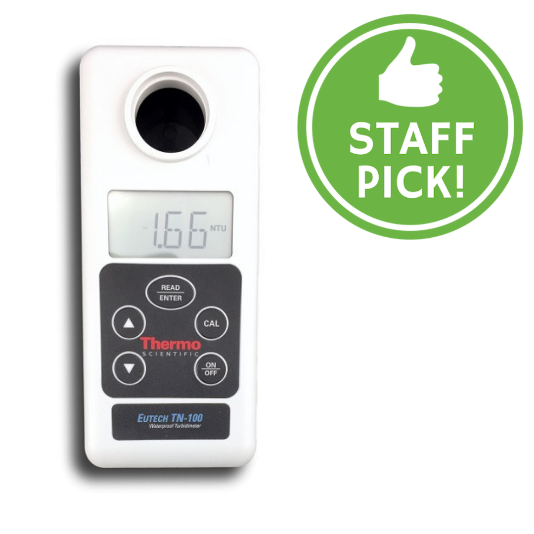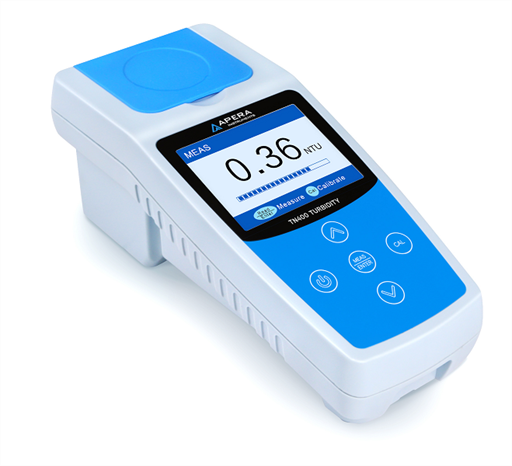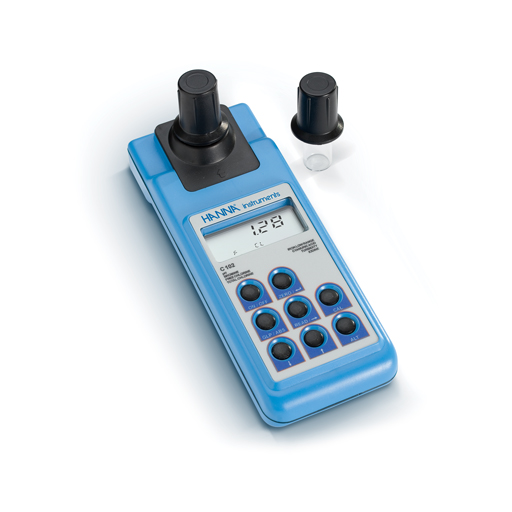What is a Turbidity Meter?

Turbidity Meters are popular tools for monitoring water quality in a range of applications that includes drinking water, as well as in lakes, rivers and mangroves. But what is a turbidity meter, and what do these devices measure?
About Turbidity
Turbidity is the haziness or cloudiness of a fluid. Turbidity is a result of suspended particles of different sizes, which are often invisible to the naked eye. As the number of particles increases, so too does the turbidity.
Early Methods of Turbidity Measurement
Secchi Disk – This was the first reference for turbidity measurement. The Secchi Disk is a black and white disk attached to a rope used to measure the transparency of water. It works by lowering the disk horizontally into the water until it is no longer visible. Once the disc becomes invisible, the attached rope scale determines visibility depth.
Jackson Turbidity Unit (JTU) – This method comprises a glass vessel with a candle mounted below. To measure turbidity using this method, pour the water sample into the glass vessel until the flame of the candle becomes covered, and radiates an even shine — the more water needed to fill the vessel, the more transparent and therefore, less turbid the sample.
These methods are not precise. Modern turbidity meters have superseded these early methods for most professional applications.
Modern Turbidity Meters and How They Work
Reference Standard
The first standard used for comparable measurements of turbidity was Formazine, and it remains the current standard used in many industries today. The principle advantage of using Formazine and diluted Formazine is the repeatability of turbidity measurements. All current turbidity measuring units refer to the Formazine standard.
Defined Units of Turbidity Measurement
- Nephelometric Turbidity Unit (NTU): NTU signifies that the instrument is measuring scattered light from the sample at a 90-degree angle from the incident light. NTU: is a standard unit of turbidity measurement, equivalent to FTU.
- Formazine Turbidity Unit (FTU): FTU became the defined unit of measurement after the acceptance of Formazine as the primary reference standard for turbidity. FTU, and any measurement units derived from or that reference FTU do not specify how the turbidity instrument measures the sample.
- Formazine nephelometric unit (FNU) - FNU signifies that the instrument is measuring scattered light from the sample at a 90-degree angle from the incident light. FNU is generally the unit of measurement used when referencing the ISO 7027 (European) turbidity method.
- Formazine attenuation unit (FAU) – signifies an instrument that measures the decrease in transmitted light through the sample at an angle of 180 degrees to the incident light.
Instrument Measurement Methods
|
IC TIP: The above units do not specify how an instrument measures a sample. For that information, consult each turbidity meter’s product specifications. |
Scattered Light Measurement – Using the scattered light measurement, a turbidity meter passes light through the water sample, and as it bounces off the suspended particles, the intensity of the light beam will change. The more sediment and suspended particles in the water, the more the scattered light becomes, and therefore the greater the impact on the light's intensity level.
Attenuation Measurement – Meters that use this measurement measure the reduction in strength of light as it passes through a sample column of water.
Light Source
Depending on the standard used in your particular industry, turbidity meters will use either infrared light at 860nm (ISO 7027) or the visible light spectrum 600-400nm (US EPA 180.1).
Examples of Turbidity Meters
Instrument Choice scientists have assembled three examples of turbidity meters together with the essential specifications you need for an overview of the range of products available.

NTU Turbidimeter, IP67, Cal Kit, Case
Product Code: EC-TN100-IR
The EC-TN100-IR is a microprocessor-based, waterproof, fast, and accurate turbidity meter. This meter is IP67 rated water and dustproof. What’s more, it floats on water and is suitable for the rigours of rugged field applications.
Units of Turbidity Measurement: NTU
Instrument Measurement Method: Scattered Light Measurement - This instrument operates on the nephelometric principle of turbidity measurement and meets the criteria specified in ISO 7027 and DIN 27027 standards.
Light Source: Infrared-emitting diode (850nm wavelength)
Range: 0 to 2000 NTU
Accuracy: < 0.1 NTU for 0.02 NTU standard; ±2 % of reading ±1 digit for 0 to 500 NTU; ±3 % of reading ±1 digit for 501 to 2000 NTU
Calibration Points: Up to 4 points; 0.02 NTU, 20.0 NTU, 100 NTU, 800 NTU

TN400 Portable Turbidity Meter Kit
Product Code: IC-TN400
The IC-TN400 is equipped with a large TFT coloured screen and is designed for easy and reliable turbidity measurements from 0 to 1000 NTU in various applications both in-field and in-lab, e.g., environmental monitoring, water treatment or beverage making.
Units of Turbidity Measurement: NTU
Instrument Measurement Method: Scattered Light ISO7207 compliant nephelometric method (90 degrees)
Light Source:Infrared-emitting diode 850nm wavelength
Range:0 to 1000 NTU
Accuracy: ≤ ± 1% of reading or 0.02 NTU, the greater of the two
Calibration Points: Up to 4 points; 0.02 NTU, 20.0 NTU, 100 NTU, 800 NTU(Polymer)

Complete Tool for Water Analysis
Product Code: HI93102
Measurements are made quickly and repeatedly through a sophisticated yet easy-to-use microprocessor. Measures Turbidity, Bromine, Free CI2, Total CI2, CYS, Iodine, LR Iron, and pH!
Units of Turbidity Measurement: NTU
Instrument Measurement Method:
Light Source: Pure green LED
Range:0.00 to 50.0 NTU
Accuracy:±0.5 NTU or ±5% (whichever greater)
Calibration Points: Up to two points; Span or two-point customised calibration
Conclusion
Modern Turbidity meters are a popular tool for measuring the turbidity of liquid samples. They are an essential water quality-indicating tool. Instrument Choice offers an extensive range of standalone devices as well as multiparameter water quality tools. There is a turbidity meter to suit every application and budget perfectly.
Want more information about turbidity or any of the products listed above? Contact one of the Instrument Choice Scientists. We’re here to help!
Call 1300 737 871 or email [email protected].
Also interesting
When searching for a weather station or a rain gauge, you might see the term ‘tipping bucket rain gauge’ often appear …what does it mean?

The consequences of not monitoring hay moisture levels can be hazardous and costly for your business or farm. Optimum moisture content within hay is of critical importance when baling and storing a safe, stable, and a more valuable product.
In this article, we will examine the importance of measuring hay moisture, and we also provide some examples of specialised hay moisture meters.

